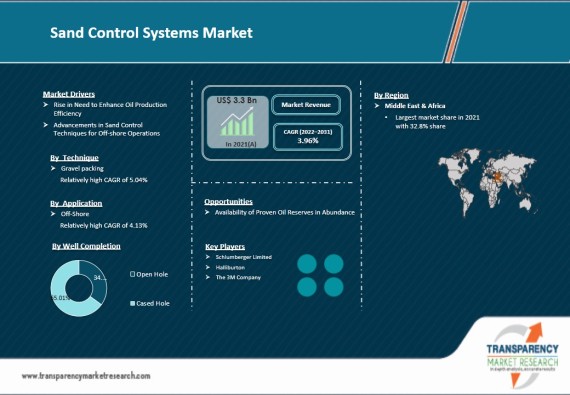The global sand control systems market in 2015 witnessed a decline due to a substantial fall in drilling and exploration activities and sharp reduction in global rig count. The decline in number of oil rigs is anticipated to last for a while, due to which, the overall growth of the market is expected to be cyclical in nature till 2020. Growth prospects are expected to rise again as global oil prices reach a steady price value. Stability in oil prices will consecutively lead to increase in drilling and exploration activities and an increased demand for a variety of sand control systems across the globe.
Transparency Market Research estimates that the will exhibit a healthy 5.8% CAGR from 2016 and 2024. If the number holds true, the market, which held an opportunity of US$3,222.5 mn in 2015, will rise to a valuation of US$5,372.8 mn by 2024.
Gravel Packing Techniques to Continue to Rank High
Of the key techniques used for minimizing sand production across a number of application areas, the ones analyzed in the report include rate exclusion, resin coated gravel, plastic consolidation, standalone screens, frac pack, and gravel packing. Of these, the segment of gravel packing held the dominant position, accounting for a nearly 29% share in the global sand control systems market in 2015. The segment is expected to witness expansion at a healthy pace in the next few years and retain its dominant position, achieving a slight rise in its overall share in the global sand control systems market by 2024.
The segment of standalone screens ranked second in terms of revenue contribution to the global sand control systems market, charting a nearly 26% share of the market’s overall revenues in 2015. The global demand for sand control screen is expected to rise at a healthy pace in the next few years, enabling the segment to take a larger share in the global market by 2024. Frac pack, accounting for nearly 18% of the global market in 2015, is also one of the most preferred sand control techniques, especially in North America and Europe. The shale gas boom in these regions has propelled the sand control systems market.
Asia Pacific and MEA to Remain Most Promising Regional Markets
Of the key regional markets for sand control systems, Asia Pacific dominated the global market 2015, accounting for a 27.5% share. Dominance of the region in the global sand control systems market can be primarily ascribed to the ongoing oil and gas well drilling and completion activities in countries such as Australia, Indonesia, Malaysia, and Myanmar. Rising population and rapid industrialization have led to a significant rise in energy demand in the region, reason why the demand for sand control systems is mounting. In terms of revenue, the sand control systems market in Asia Pacific region valued US$886.8 mn in 2015 and is expected to remain the most attractive regional market in the years to come.
The market for sand control systems in Middle East and Africa is driven by large offshore discoveries and huge proven oil reserves in countries such as Saudi Arabia and UAE. Vast drilling activities across the region also make it an attractive market for sand control systems. Moreover, new oil and gas discoveries in countries such as Nigeria and Angola are expected to further boost the market.
Request to view Sample Report:
The competitive landscape of the global sand control systems market is highly consolidated, with the top four companies accounting for a collective share of over 92% of the overall market in 2015. These top players in the market are Schlumberger Limited, Halliburton Company, Weatherford International, and Baker Hughes, Inc. Other notable vendors in the market are Superior Energy Services, RPC Inc., Inc., Welltec A/S, Grit Industries, Inc., and Tendeka.
